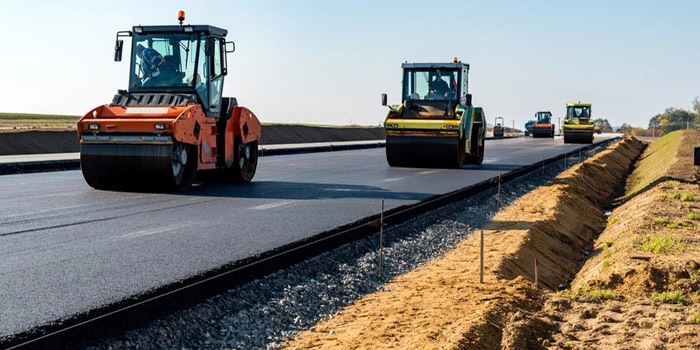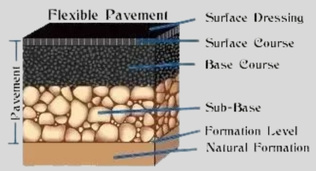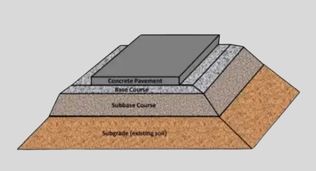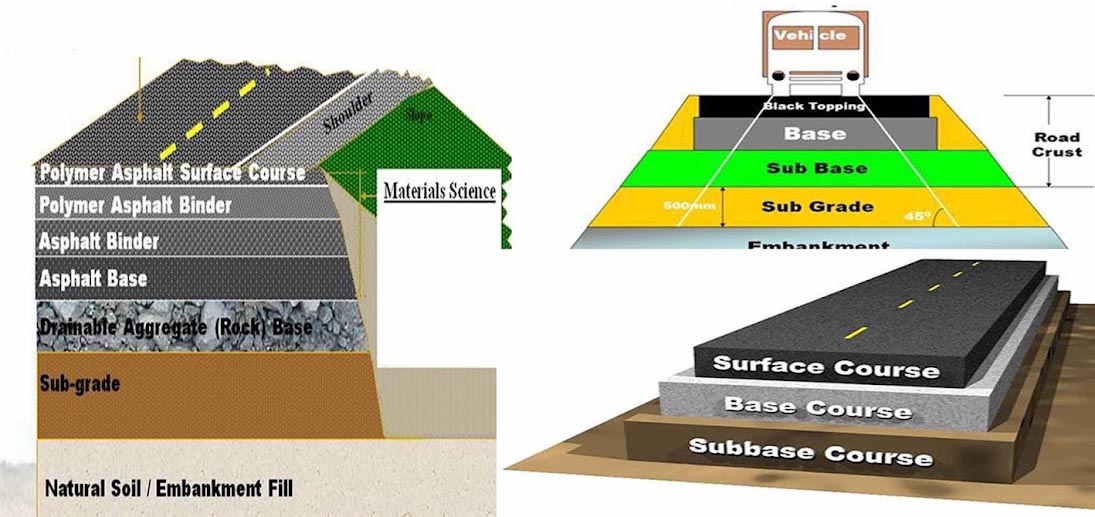You may already know that roads are not made of one solid piece. Actually, they are built into road pavement layers to stay strong and last longer.
Today, you will learn what road pavement is and its eight major layers. We will also tell you about the materials that you can use in each layer of road pavement.
What is a Pavement?
Pavement is the top hard layer of a road. This layer of pavement is strong and smooth, so you can ride easily. It also protects your road from rain, sun, and other damage. Without pavement, the road can crack or become muddy.
That’s why pavement is an important part of road construction. Moreover, it increases the lifespan of your road. So that you can walk, drive, or ride on it from one place to another.

Types of Road Pavement
Road pavement has three main types. Each is made in a different way and has its own unique properties. Below are categories of road pavements.

Flexible Pavement Layers
Flexible pavements are roads that bend slightly when your vehicles move over them. Generally, they don’t have much bending strength, but they can still handle heavy traffic loads. For this purpose, it spreads the pressure across different layers.
In the top layer of flexible pavement, you should use strong material throughout for the lower layers; you can add weak materials.

Rigid Pavement Layers
The rigid pavement layer is mostly made with concrete. Its top layer contains a thick concrete slab. This structure is enough to carry all the traffic load.
Below it, you will find a base layer that is made of strong crushed stones. Usually, rigid pavement layers do not bend as much as flexible pavement. They have the ability to stay firm even with your heavy trucks.

Composite Pavement
You will spot composite pavement when two different pavement types are used together. This layer has properties of both rigid and flexible pavement layers. As a result, you will have a road with extra strength and a smooth surface. You should choose this method when you need strong as well as easy to repair roads.
8 Layers of a Road Pavement
To make strong and durable roads, engineers made roads with multiple layers of pavement. All these parts are stacked on top of each other stepwise.

1. Compacted Subgrade
The compacted subgrade is the bottom layer of the road. It is made from soil that is tightly pressed down. This layer serves as the foundation of your road because it holds all the top layers.
So, when you construct a compacted subgrade layer, then your road can easily break. You must build it strong and flat to provide strong support for your road.
2. Sub-Base Course
This pavement layer is set at the top of the compacted subgrade. You should use strong materials such as crushed stones, burnt clinkers and gravel to make it. It carries the weight of your cars and heavy trucks.
Basically, it acts as a barrier to stop water between the top & bottom layer. Hence, you will see the road will always be dry and strong. In this way, it provides extra support to all top layers.
3. Base Course
The base course is stronger than the sub-base layer. It is also made of crushed stones but can handle heavy traffic/weight.
Actually, it shares the heavy load of your cars and trucks to the layers below. This helps you to stop cracks and maintain smoothness of the road.
4. Prime Coat
The prime coat is a thin layer of special oil or liquid. You can spray it on the road before you add asphalt. For this purpose, you should use materials such as cutback bitumen or bitumen mixed with water.
It creates a base for the next pavement layer to make sure it can stick better. Well, it is a small layer, but very important for you to have a smooth road.
5. Binder Coat
Blinder coat layer is the mixture of stone with very thick black tar. Its main function is to hold the top part of your road in place. With this layer, roads can stay longer and never get cracked easily. Additionally, the binder coat also helps your top layer stick well.
6. Tack Coat
In road construction, the tack coat is a thin pavement layer. You should always add this layer before you install a new layer of asphalt. Because it works like glue between the layers. Without it, your top layer of pavement might slip or move. It provides stability and helps the road stay strong when you drive on it.
7. Surface Course
The surface layer is that part of pavements which you generally see and drive on every day. This is made with a mixture of small stones and bitumen. It is a smooth, strong layer which is built to last.
The surface course can handle your most traffic. Moreover, it also protects the lower layers from heat exposure and rain damage. Also, it helps water flow off the road, so it does not collect in puddles.
8. Seal Coat
Finally, the seal coat is the last layer on top of your road. It is a thin layer of liquid bitumen & asphalt. Sometimes, you can add small stones too.
It also helps you to stop enlargement of small cracks on roads. You will see that the road is smooth and shiny when you add a seal layer.
Road Layers and Materials
Each road pavement layer is made with special materials. For example: the bottom layers (subgrade and sub-base) are made of soil, gravel & crushed stones. It provides hold power and gives support for other parts of the road.
Next, the base and binder layers contain stronger stones which you can mix with bitumen. They can carry heavy loads and help the road last longer.
Above that is the surface and seal coat layers which use fine stones and liquid bitumen. Its major role is to keep your road even and protect from external damage as well.
Layers of Rigid Pavement
- Concrete Slab: This is the top and hardest layer of rigid pavement. Thick concrete is used to make it. However, it does not bend like asphalt.
- Base Course: Base course layer is added to provide extra support to concrete. Mostly, it uses smashed stones and gravel as materials. To maintain the load, it shares weight with lower layers.
- Sub-Base: For sub base formations, engineers use mixed solutions of crushed stones and sand. Its major role is to protect achievement from water damage and prevent cracks.
- Subgrade: This bottom layer of rigid pavement contains compacted natural soil. If your subgrade layer is weak, the whole road can be damaged. That’s why you have to make sure it is firm and even.
Road Pavement Layers: Benefits and Disadvantages
The following are some advantages of road pavement layers.
- When your roads have strong pavement layers, they can not be damaged easily and last longer.
- Roads can handle your large, heavy vehicles, such as trucks and buses.
- It protects the road surface from cracks and holes.
- Pavement layers are beneficial in sharing the load evenly so that your road can not sink (go lower).
- If you notice that one pavement layer is broken, you can fix it without repairing the whole road.
Road pavement layers also have some negative points such as:
- If your foundation layer is weak, then your whole road can get damaged (even if the top looks fine).
- You have to spend more money to use strong materials and build each layer properly.
- You will observe that the soil may not be strong enough to hold all the layers of your road in some places.
- When you are required to repair the deepest layer, it will be hard for you because this can only be done by big machines and highly professional workers.
Подводя итоги
To summarize, we can say that if you want to build strong roads, you must follow smart design, strong pavement layers, and careful planning. You can see how road pavement layer construction makes your road safe for driving. For your further inquiries, you can contact us today for expert road safety and construction solutions.


-80x69.png)

